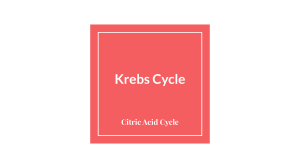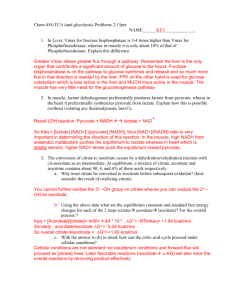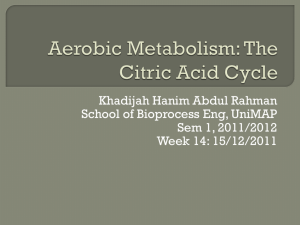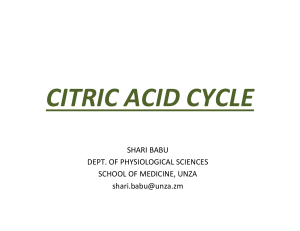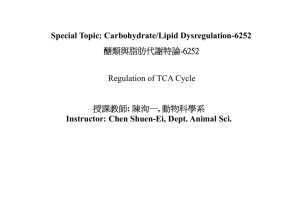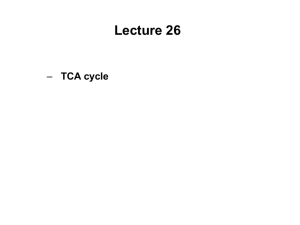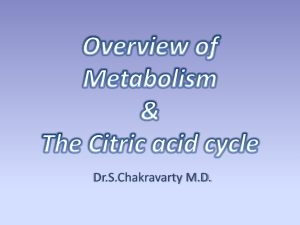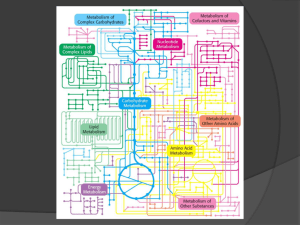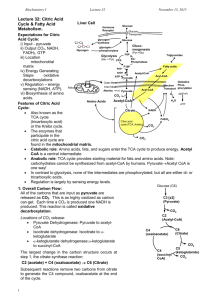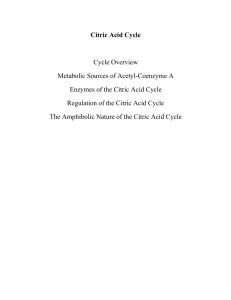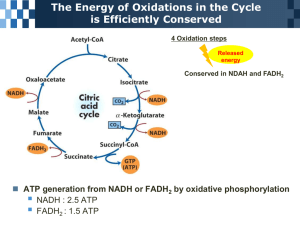chap16
advertisement
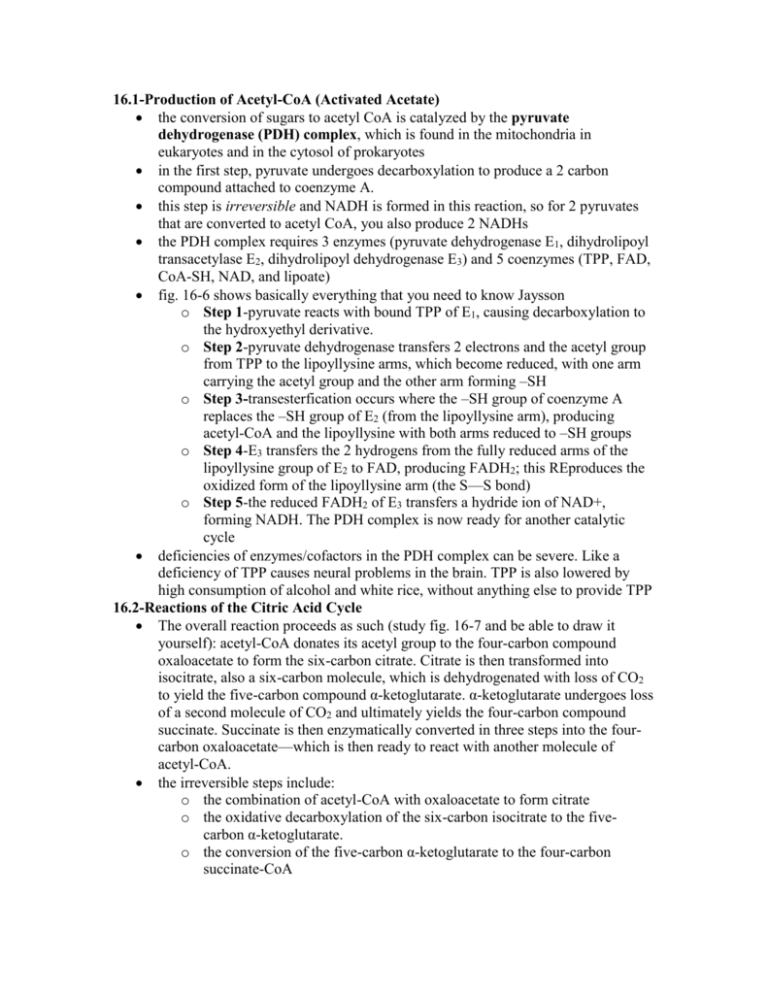
16.1-Production of Acetyl-CoA (Activated Acetate) the conversion of sugars to acetyl CoA is catalyzed by the pyruvate dehydrogenase (PDH) complex, which is found in the mitochondria in eukaryotes and in the cytosol of prokaryotes in the first step, pyruvate undergoes decarboxylation to produce a 2 carbon compound attached to coenzyme A. this step is irreversible and NADH is formed in this reaction, so for 2 pyruvates that are converted to acetyl CoA, you also produce 2 NADHs the PDH complex requires 3 enzymes (pyruvate dehydrogenase E1, dihydrolipoyl transacetylase E2, dihydrolipoyl dehydrogenase E3) and 5 coenzymes (TPP, FAD, CoA-SH, NAD, and lipoate) fig. 16-6 shows basically everything that you need to know Jaysson o Step 1-pyruvate reacts with bound TPP of E1, causing decarboxylation to the hydroxyethyl derivative. o Step 2-pyruvate dehydrogenase transfers 2 electrons and the acetyl group from TPP to the lipoyllysine arms, which become reduced, with one arm carrying the acetyl group and the other arm forming –SH o Step 3-transesterfication occurs where the –SH group of coenzyme A replaces the –SH group of E2 (from the lipoyllysine arm), producing acetyl-CoA and the lipoyllysine with both arms reduced to –SH groups o Step 4-E3 transfers the 2 hydrogens from the fully reduced arms of the lipoyllysine group of E2 to FAD, producing FADH2; this REproduces the oxidized form of the lipoyllysine arm (the S—S bond) o Step 5-the reduced FADH2 of E3 transfers a hydride ion of NAD+, forming NADH. The PDH complex is now ready for another catalytic cycle deficiencies of enzymes/cofactors in the PDH complex can be severe. Like a deficiency of TPP causes neural problems in the brain. TPP is also lowered by high consumption of alcohol and white rice, without anything else to provide TPP 16.2-Reactions of the Citric Acid Cycle The overall reaction proceeds as such (study fig. 16-7 and be able to draw it yourself): acetyl-CoA donates its acetyl group to the four-carbon compound oxaloacetate to form the six-carbon citrate. Citrate is then transformed into isocitrate, also a six-carbon molecule, which is dehydrogenated with loss of CO2 to yield the five-carbon compound α-ketoglutarate. α-ketoglutarate undergoes loss of a second molecule of CO2 and ultimately yields the four-carbon compound succinate. Succinate is then enzymatically converted in three steps into the fourcarbon oxaloacetate—which is then ready to react with another molecule of acetyl-CoA. the irreversible steps include: o the combination of acetyl-CoA with oxaloacetate to form citrate o the oxidative decarboxylation of the six-carbon isocitrate to the fivecarbon α-ketoglutarate. o the conversion of the five-carbon α-ketoglutarate to the four-carbon succinate-CoA the irreversible reaction of acetyl-CoA + oxaloacetate citrate, is catalyzed by citrate synthase the reversible conversion of citrate to isocitrate is catalyzed by aconitase, through the removal and addition of water. This reaction is driven to the right because isocitrate is rapidly removed in the next step the irreversible conversion of isocitrate to α-ketoglutarate is catalyzed by isocitrate dehydrogenase. NAD+ is required as an electron acceptor in this reaction, and therefore NADH is formed; it is found in the mitochondrial matrix. in the last irreversible reaction in the Kreb’s cycle, α-ketoglutarate is converted to succinyl-CoA through the α-ketoglutarate dehydrogenase complex. This complex is almost identical to the PDH complex. NADH is formed in the process and CO2 is released in the reversible conversion of Succinyl-CoA to Succinate, the reaction is catalyzed by succinyl-CoA synthetase. The energy released in the breakage of the CoA bond is conserved in the formation of ATP or GTP, which can easily be converted between each other by nucleoside diphosphte kinase the conversion of succinte to fumurate is catalyzed by succinate dehydrogenase. It results in the formation of FADH2 from FAD. Malonate, an analog of succinate is a strong competitive inhibitor of succinate dehydrogenase, and its addition to the mitochondria blocks the activity of the citric acid cycle fumarase converts fumarate to malate, and it is highly stereospecific in the last step of the Kreb’s cycle, malate is converted to oxaloacetate by Lmalate dehydrogenase. This also results in the formation of NADH. This reaction is not energetically favorable, but it proceeds to the right because oxaloacetate is quickly used in the citrate reaction during oxidative phosphorylation, a NADH molecule can yield 2.5 ATPs and a FADH2 can yield 1.5 ATPs. So when both pyruvate molecules are oxidized to 6 CO2 via the pyruvate dehydrogenase complex and the citric acid cycle, and the electrons are transferred to O2 via oxidative phosphorylation, as many as 32 ATP are obtained per glucose. That is close to 976 kJ/mol. KNOW AND UNDERSTAND figure 16-15 and table 16-2 16.3- Regulation of the Citric Acid Cycle The regulation of the citric acid cycle involves regulation of the PDH complex and the enzyme citrate synthase. But acetyl CoA is also produced and regulated through other pathways like through the oxidation of fatty acids and certain amino acids—and the availability of intermediates The activity of the pyruvate dehydrogenase enzyme is highly regulated by excess fuel like long chain fatty acids, a high ratio of ATP/ADP, and NADH/NAD+. The PDH complex is also regulated by covalent modification. It is inhibited by the reversible phosphorylation of a specific Ser residue on one of the two subunits of E1. o A protein kinase inactivates E1 through phosphorylation (in response to high levels of ATP) o A phosphatase reactivates E1 by cleaving the phosphate off the enzyme Basically, the kreb’s cycle is regulated by feedback inhibition of ATP, citrate, NADH, etc. on the 3 majors enzymes (citrate synthase, α-ketoglutarate dehydrogenase, and isocitrate dehydrogenase 16.4- The Glyoxylate Cycle Vertebrates can’t convert fatty acids, or the acetate derived from them to carbohydrates Although the carbon atoms of from acetyl-CoA that enter the kreb’s cycle appear 8 steps later in oxaloacetate; there is NO NET CONVERSION TO OXALOACETATE in vertebrates. For every 2 carbons that enter the cycle as acetyl-CoA, two leave as CO2. Enzymes in the glyoxylate cycle (found in plants, invertebrates and microorganisms) catalyze the net conversion of acetate to succinate or other 4carbon intermediates of the Kreb’s cycle In the glyoxylate cycle, acetyl-CoA combines with oxaloacetate to form citrate and then isocitrate is formed (like in the kreb’s cycle), but then, isocitrate is cleaved by isocitrate lyase, forming succinate and glyoxylate. Glyoxylate then condenses with a 2nd molecule of acetyl-CoA to form malate, which is subquently oxidized to oxaloacetate. In plants, the glyoxylate cycle enzymes are stored in memgrane-bound organelles called glyoxysomes. Glyoxysomes contain all the enzymes needed for the degradation of the fatty acids stored in seed oils
